In 2011, Eric Ries published The Lean Startup. It quickly became a bestseller and a core part of many university courses. In the book, Eric outlined a business model for startups using complex-sounding business terms like lean management, minimum viable product, and agile development.
These buzzwords and the theories they represent have become part of the vocabulary of entrepreneurs, especially in the tech sector. People use the phrases to sound intelligent and (let’s be honest) to confuse outsiders. Yet buzzwords don’t make a business.
The key to success as per The Lean Startup is the simplicity of the business model, which is outlined in the book. It can be applied to any venture. The principles are especially useful for building and growing online companies and testing new revenue streams. It also happens to be a good way of saving time and money.
Before getting into the practical side of this article, let’s first define a minimum viable product. After all, you want to sound intelligent if you ever find yourself in a boardroom.
What Is a Minimum Viable Product?
A minimum viable product is the least amount of work you can put into your website or product to test a business idea. Once you’ve found out that people are interested in what you’re doing, you can invest more time and money in making it better. Or, to put it into more business-friendly terms…
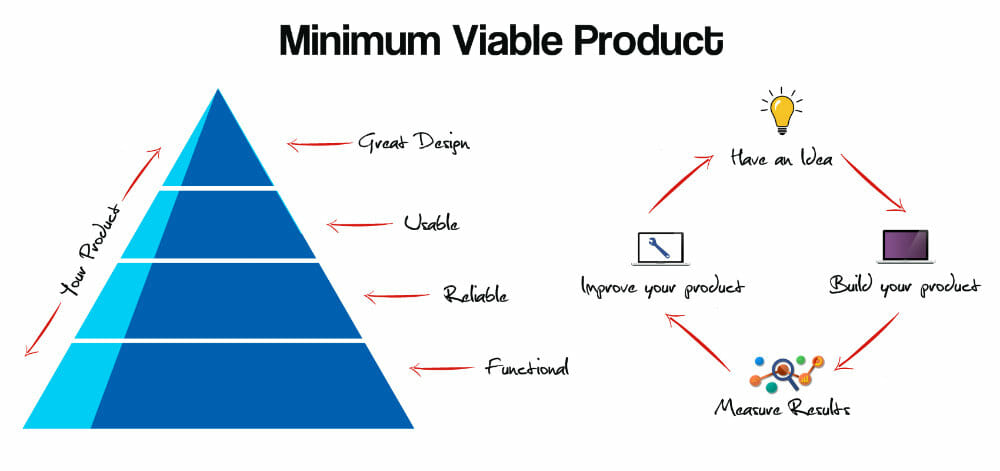
The final product is developed through user feedback. You can see that it’s basically about saving time and increasing profit. These are two ideas that are never going to go out of fashion, as Tim Ferris proved with his book 4-Hour Workweek.
Further Reading:
- How to Build a Strong Personal Brand Using Webinars
- Making Data-Driven Decisions for Better Website UX
- The Startup Story You Didn’t Hear About: The Billion Dollar Company That Was 4 Days From Going Bankrupt [podcast]
4 Kickass Case Studies
You’ll find a lot of information online about how the principles of a minimum viable product can be applied to a business. The problem is that most of the popular case studies are for million-dollar giants (don’t get me wrong, nothing bad about a million-dollar business, it’s just that we’re not all at that level yet).
Instead of focusing exclusively on mega companies, we will cover a few different ways you can use the minimum viable product development model with smaller businesses. Here’s a quick overview:
- The 3-Page Website: How to Sell an New Idea
- From 0-$3,000 a Month: How to Grow Your Website Income
- Avoiding Overspend: Things to do Before Hiring a Programmer
- Growth Hacking Your Way to a Software Empire
I’ll start with something that’s probably relevant to all those entrepreneurs out there: how to cheaply launch a business.
1) The 3-Page Website: How to Sell an Idea
One of the hardest things about being an entrepreneur is dealing with failure. It’s the dark side of success and happens far more often than we care to admit. According to a widely cited Internet stat, 8 out of 10 businesses fail within the first 18 months.
Like too many online stats, this one is bogus. It does sound correct though, which is why people like to quote it (a less quoted, but more reliable, stat found that 25% of businesses failed in their first year).
Regardless of the number, a failed project costs money, time and causes the founders to get depressed. Given that businesses have such a high failure rate, it seems logical that you want to find out if your idea is rubbish quickly and for the least amount of cash.
An easy way to test the demand for a new service is to create a two- to three-page website. This skeleton website is your minimum viable product. Share on XIt will have:
- Sales Page: Marketing material for your product or service.
- Sorry Page: Apologize if you’re not selling the product or offering the service and try and collect website visitors’ email addresses.
- About Page: Blurb about your business with an optional contact form just in case they want to get in touch.
You can launch a basic website over a weekend, which is what I did with Launch Space. The idea is not necessarily to sell a product or service, but rather to use the marketing material to test the demand for a product (it’s great if you have something to sell, of course).
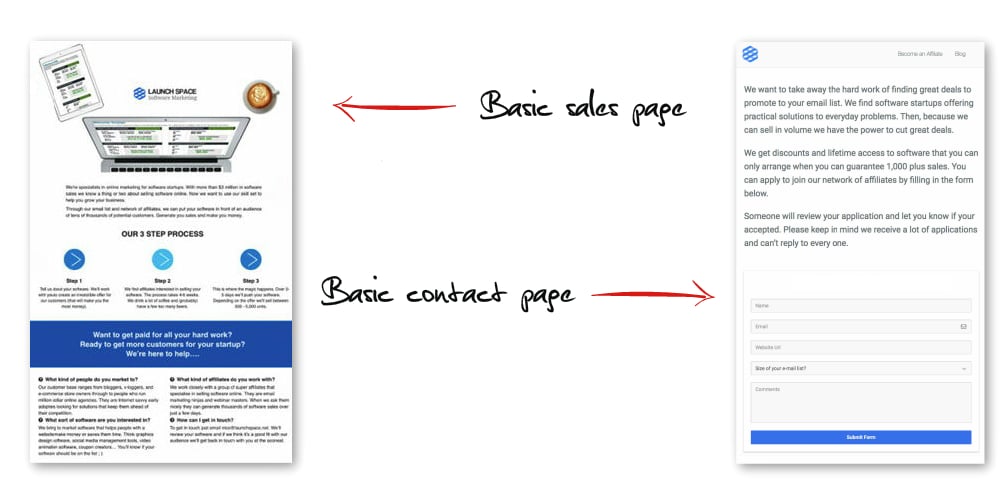
You can run Facebook ads to drive leads to your sales page. Alternatively, you could use direct marketing to test demand for your service. You can find a good case study of how to use direct marketing to grow a business using the minimum viable product model in this article, where we show how we made $30,000 from a 3-page website with no traffic.
When you’re running your test, make sure to track the results. If you’re generating real or hypothetical sales, then you’ve validated your business idea. You can then invest your time and money into developing the project.
If you’re not generating any leads, you either need to work on your sales copy or rethink your business plan. Even though that might be depressing, it’s a lot better than discovering this three months into a project after spending thousands developing your product (I found this out the hard way).
Further Reading:
- 53 Alternative Ad Networks to Open Up New Channels of Growth in 2018
- Growth Hacking Tactics to Get 10M Users in 3 Years (Without Paid Ads): An Interview with Melanie Perkins [podcast]
- How We Built the Growth Everywhere Podcast to 109,000 Listens per Month
2) From 0-$3,000: Growing Your Website Income
Next up is how to apply the minimum viable product model to increase your income. The first time I used this system was on a blog in the travel niche that was getting between 50,000 – 60,000 unique visitors a month.
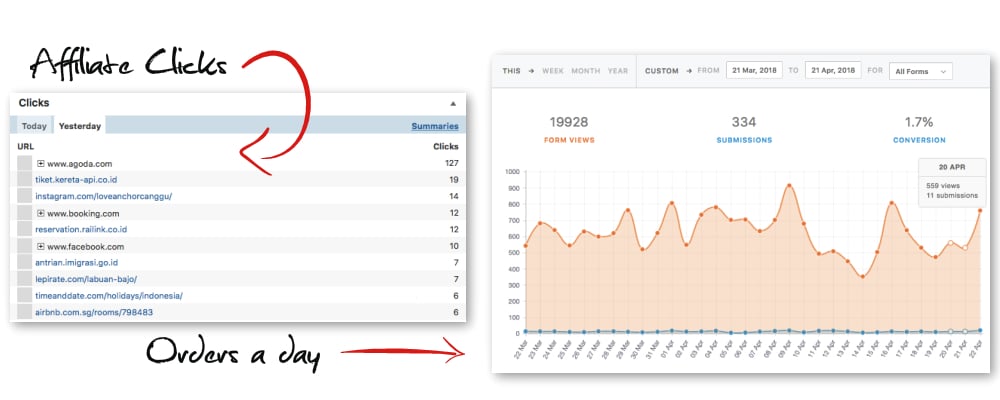
When I got involved with the site, it was primarily making money from paid-for guest posts. Six months later, the site was making about $2,000-$3,000 a month. The income came in the form of direct orders to various partner programs, direct partnerships and passive affiliate income. It’s not a life-changing salary, but it’s obtainable for a lot of bloggers.
The starting point for this process is of course finding relevant products and affiliate programs to support. There are too many variables in play for me to tell you how to do this, but if you’re struggling to find suitable products, just check out what other people in your niche are doing.
When you’ve got a list of potential products, you’ll need to do a content review of your site. I use Google Docs for this. The three columns you need on your XL sheet are:
- URL of the article
- Topic your article covers
- Number of visitors a week
Now choose a product you want to test. Insert a link to the product you want to promote, or a link to an article you were thinking of writing on the subject, on the five most popular articles that are loosely related to that topic.
Sticking to the travel niche example, you might think that your audience would purchase a tour from you. To test this idea, you could have a link to a tour package you want to offer (or article on the topic).
Place the link in the first four paragraphs of the content. I recommend that you put a link to this content on a separate line. Here’s what the link might look like:
Interested in travel: Check out our Ultimate 3 Day 2 Night in Los Angeles Package
This link will look ugly. In fact you could call this technique The Ugly Income Plan. The appearance of the links is not the only problem with The Ugly Income Plan. Visitors to your site from Google or social media expecting one piece of content probably won’t be interested in something different.
Yet this doesn’t matter. If your audience doesn’t click on your ugly link, you will find it hard to get them to buy the product from a great-looking sales page or an awesome article.
To test a product or service, I normally leave a link live for about a week. This gives me a baseline about interest in the product. If nobody clicks on the link, I know it’s going to be difficult to monetize the product or service. On the other hand, if people click on the ugly links, then I know there’s interest.
While it’s not perfect, this minimum viable product model saves a lot of time. I want to see results before investing my time and money into doing keyword research, paying people to write relevant content or even paying designers to create sales pages in the hope that things will work out.
You can run this system with multiple products at the same time across your site to test different income streams. It’s a good way of validating demand for services and allows you to scale your business.
If you’re running a website or a business where appearance matters, there are alternatives to The Ugly Income Plan. You can insert links in a more natural way, use sidebar advertising or add a new tab in the menu linking to a ‘Coming Soon’ page. All of these different methods apply the same minimum viable product model to test the demand.
3) Avoiding Overspending: Things to Do Before Hiring a Programmer
As Apple shows you with almost every product they release, there is something special about a beautiful product. The Apple website even looks like it’s been designed by a Japanese Feng Shui master who spent a decade in design school.
The thing is, creating a beautiful website takes time. Cheap out-of-the-box solutions are never very pretty and probably don’t offer the complex functionality that you want. On the other hand, creating the perfect solution to meet your ideal needs will be expensive.
Take Airbnb. A quick browse of the website and you’ll find plenty of well-thought-through features that undoubtedly took months of time and tens of thousands of dollars to develop. The booking form is the perfect example: there’s a slider for selecting a property by price, you can choose the filters, plus a whole lot more.
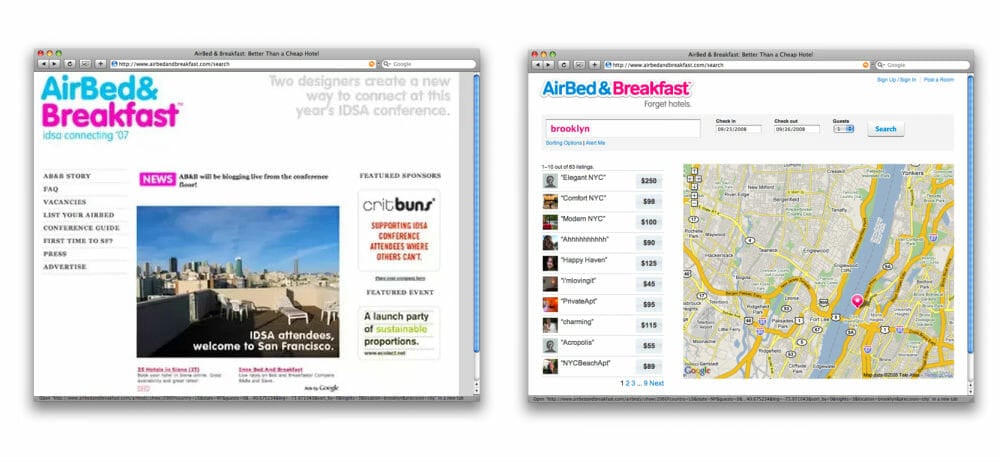
Of course, Airbnb didn’t start off looking like this. The original website was a landing page where the CEOs of the company offered spare rooms in their house to people attending the IDSA conference in San Francisco.
After validating their business idea by getting some guests to stay at their house, they invested in the website. This is the basis of the minimum viable product development cycle: profit and invest, profit and invest. You can find a good case study on how Airbnb grew using these tactics on Fueled.
Further Reading:
- 10 Lessons Startups Can Learn from Uber’s Growth
- 30 Brands with the Best Digital Marketing Campaigns
- What Is Growth Hacking?
4) Growth Hacking Your Way to a Software Empire
A key part of the minimum viable product development cycle is user feedback. I’ve not really covered how to integrate user feedback in the the previous case studies, so I’ll cover this in a bit more depth in this section. But first…
Creating a minimum viable product is a core part of software development. For example, most gamers are familiar with the software release life cycle, which includes the Alpha, Beta and release phases. The same is true for marketing software. If you’re building an online software company, you’ll find a lot of engaged communities of early adopters that want to use beta products.
If you want to promote your software and test the demand for your service, the two most active communities of early adopters are Betalist and Product Hunt. With Betalist, you need little more than a sales page to get listed. Product Hunt, meanwhile, is more about bringing attention to products that are close to the release stage of the software life cycle.
To succeed on either platform I suggest you offer early adopters a reduced or special price on your product. In exchange for this, the users will provide feedback on how to improve the software (and, hopefully, not complain too much about the bugs they find).
I won’t cover how to get user feedback in any depth. There are already enough great articles covering the topic online. This one from USAbility Hour on user feedback you need to create a better product is a really good example.
Which brings us nicely round to how to act on user feedback. As mentioned, this is a key part of the minimum viable product development cycle.
You will get a lot of feedback from early adopters and customers. Unfortunately, much of it isn’t helpful. It can best be categorized as a client wishlist – features they’d love to have, but would probably never buy.
What you need to find is the feedback that will help you grow your business (the InVisionApp blog has a good article on the topic). You’ll need to use a mixture of intuition and logic to pick the right feedback. You will make mistakes, but if you use the minimum viable product development cycle they will hopefully not be too costly.
After reviewing all the suggestions you need to develop your product, I recommend that you share your development plan with your customer base. A lot of companies, and Ninja Outreach is a good example, use public boards on Trello to do this:
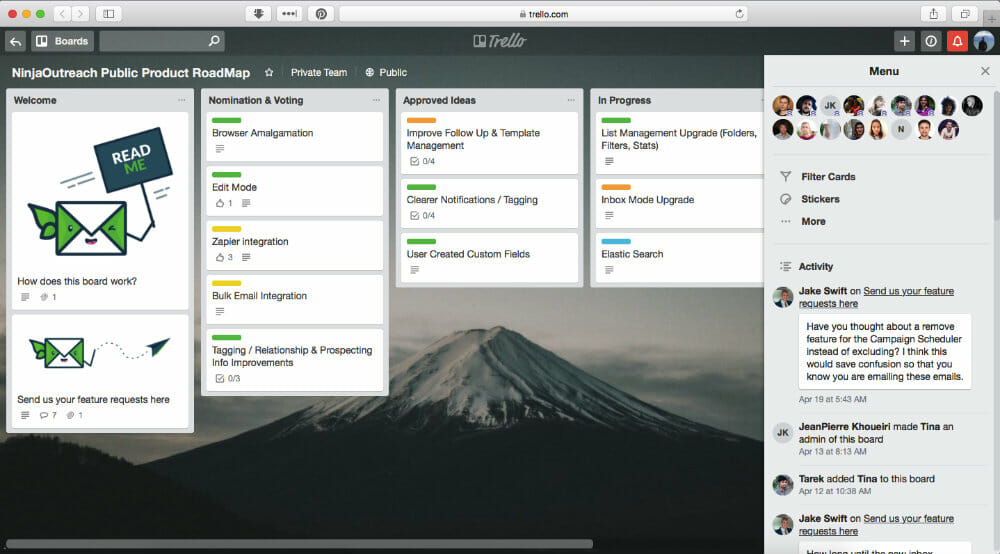
Sharing your development plan gives your audience a sense of where your company is going, that bugs are being dealt with, and new features that are being developed. More importantly, it fosters a sense of ownership and community around the product, which will extend the lifetime value of your core customers.
Conclusion
At its heart, the minimum viable product theory is really about reducing waste. Whatever your niche, there is nothing more disheartening than spending weeks or even months of your life developing the perfect product only to find out that nobody is interested in it. And as crazy as it might sound, a lot of companies develop products this way.
Hopefully this article has inspired you to take a few shortcuts and validate your business ideas earlier. This way you can spend more time focusing on projects with potential, rather than the ones with little hope of success.






